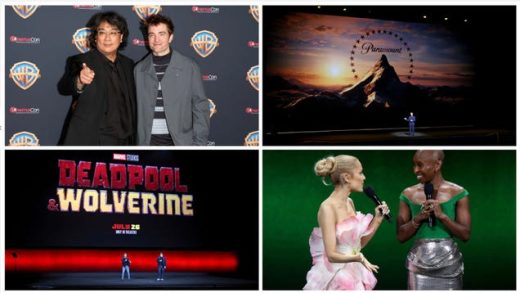No matter how much I rationalize the new iPhone, I always feel like I’m not fooling anyone. Do I need it? No. Do I want it? Probably. Do I have a plan for how to justify it to my family without triggering a new round of upgrades? There’s where my sales pitch becomes the script I need to debunk when my filmmaker daughter finally checks in with her iPhone 10 with broken screen and cracked glass back.
It’s a well known fact that the new iPhone feels faster, more powerful, able to leap tall buildings in a single bound. For about one day. Then it settles into the rhythm of daily life where soon it feels exactly like the one it replaced. Physically, the notch at the top of the 12 Pro Max shrinks in the 13. That’s pretty much it. There’s a lot going on with the camera that’s new, but the hardware changes are in service of the software, not the other way around.
Even so, the details of the new features do not tell the real story of why I must have this 13 Pro Max or whatever the hell it’s called. Techcrunch editor Matthew Panzarino is the one who opened my eyes and eventually my wallet. Apparently every year he goes down the I5 to Disneyland and tests out the new iPhone as he tours the park. This year he combined an interview with two of the Apple engineers with the results of his camera test. The results are stunning.
On this edition of the Gillmor Gang, we handicap how soon we’ll get the 13. None of this is why we’ll jump. Not the professional rack focus pullers of which there are none. After a year of the pandemic, there’s no real percentage in showing off the new phone in meetings we’re still not having. My fundamental problem is that I am still a few months from reaching the one year mark on my Update program. I pay a monthly charge on a 2-year contract but after 1 year I can restart another 2 year contract with the latest phone. Everyone else is tipping over fast as the Gang drools over the supposed leap of innovation. Even now I’m slipping back into so what mode.
But then there’s Matthew’s video. As his conversation with Apple proves, this is not just about rack focusing. It’s all about anticipating coming into the frame and taking advantage of overscan, which uses extra pixels around the video to smooth out camera jiggle. It’s about adding a layer of sensor to create a depth map that you can control with software to draw the viewer’s eye toward the dramatic focus of the scene. It’s about inculcating the footage with a sense of the intuitive algorithms filmmakers use in sculpting the flow of the scene into a more pleasurable experience.
That’s the real hook of the new tools. It’s not about the professionals getting cheaper, lightweight, more flexible power tools. It’s about giving us, civilians, the tools to silently and subtly create a product that looks better, slicker, smoother, a more excellent version of reality that we will appreciate as we remember not the event, but the experience recorded and enhanced of the event. Matthew’s camera dollies along the Happiest Streets on Earth, and all he had to do was interact with the streetsmarts of the system. When his daughter turned from looking behind her at the camera, the focus gracefully shifted to the rest of the family in front of her.
I brought this up on a Gang livestream recording session, and all hell broke loose. Basically, the consensus was that these incremental advances of Apple’s roadmap did not add up to an important moment in history or progress or just plain new cool stuff. I thought the impact on professional filmmaking might be less significant than others did. I thought back to my time in film school, first at Brandeis and later at California Institute of the Arts. I had gone to Cal Arts because of the presence of its dean, classic comedy director Alexander (Sandy) Mackendrick of The Man In the White Suit fame. He had worked his way up in the business as a writer, and in his class at Cal Arts produced a set of notes and principles of dramatic writing he later published as a book. But the blend of English filmmaking with its never-a-missed-step precision and the popular comedies of Ealing Studios was catnip for a 21 year old who had just missed the shutdown of Hollywood’s Golden Age.
Cal Arts was a complete cluster of an improvisation, funded by the Disneys but commandeered by the radicals and misfits of the Golden Age of gonzo experimentalism, aka the Sixties. In the first year of its existence, we lounged naked around the pool at the earthquake-damaged campus of Villa Cabrini in downtown LA. 10 blocks away stood the Bradbury Building, where ‘40s detectives rode the gilded-caged elevators in hundreds of films and then television shows.The backlots were further West, in the process of being sold off for real estate development projects. As the Seventies neared, power was shifting to the music business in the wake of the Beatles’ overthrow of production, songwriting, graphic design, and the studio system in general.
In its first official year, Cal Arts relocated to the still under construction campus in Valencia at the upper end of the Valley. A concrete fortress at the top of a hill, the school felt much more like a trade school for burgeoning animators than the dialectic political stew of the students and their professors. In 1968, Jean-Luc Godard filmed the Rolling Stones during recording sessions for their Beggars Banquet album. As Godard’s crew dollies slowly around Olympic Studios, a song begins to take shape as the Stones’ founder Brian Jones disintegrates in the corner behind a baffle. Sympathy for the Devil documents the Stones’ recording process as it occurs, morphing from an acoustic folk song to a rhythmic samba punctuated by overdubs where Jones, Wyman, Watts, and studio denizens chant “wooo wooo” as a response to the lyric Who Killed the Kennedys.
Out of chaos comes beauty and power, staring insolently in the face of death, drugs, and dissolution. The pathetic image of Jones slumped over an unmixed acoustic guitar speaks volumes to the way the rock culture eats its young. A film performance of the track a few months later in the Stones’ Rock and Roll Circus reveals Jones playing maracas front and center in the live mix to great effect. His last public performance before his death at the bottom of his swimming pool, the alchemy that manifested itself in the early Stones proved more resilient than the players themselves. Years later, a live performance in St. Louis was the first without Charlie Watts and with session drummer Steve Jordan. It takes some time for the players to notice, but Sympathy for the Devil continues as a platform for the thing that the Stones persist. You can feel the spirit of the times, but also the possibilities for the future. After all, it’s you and me. Woooo woooo.
the latest Gillmor Gang Newsletter
__________________
The Gillmor Gang — Frank Radice, Michael Markman, Keith Teare, Denis Pombriant, Brent Leary and Steve Gillmor. Recorded live Friday, September 17, 2021.
Produced and directed by Tina Chase Gillmor @tinagillmor
@fradice, @mickeleh, @denispombriant, @kteare, @brentleary, @stevegillmor, @gillmorgang
Subscribe to the new Gillmor Gang Newsletter and join the backchannel here on Telegram.
The Gillmor Gang on Facebook … and here’s our sister show G3 on Facebook.
Source : Gillmor Gang: Wooo Wooo













